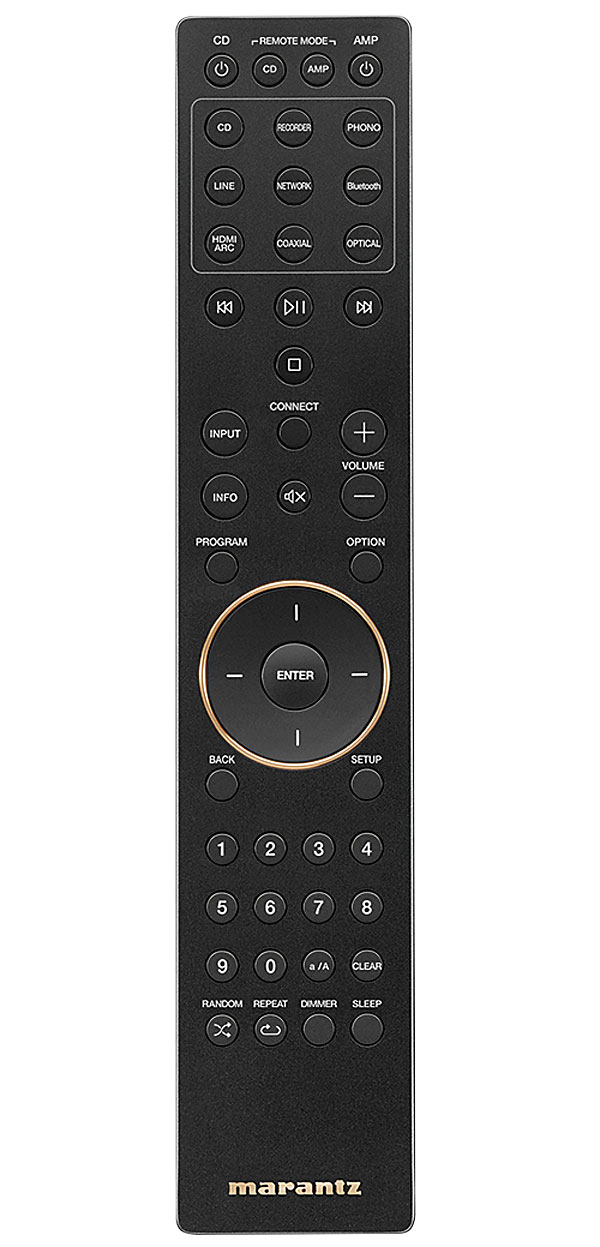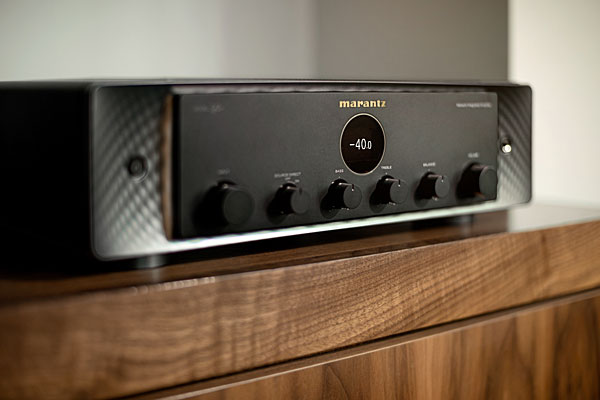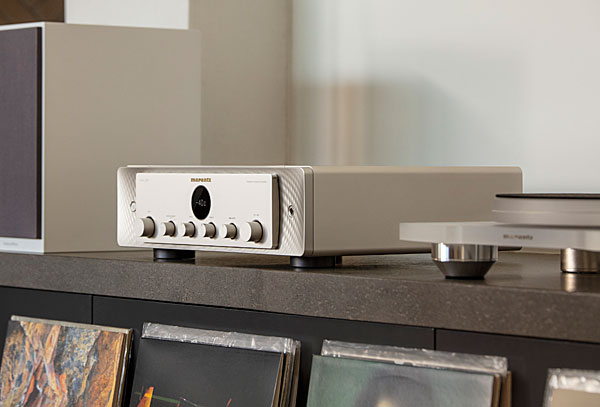| Columns Retired Columns & Blogs |
this is so iconic
Sound
I began with HEOS and selected the connected USB drive as source so that I could jump right in with some familiar music. The far ends of my speaker cables were already connected to a newly arrived pair of KEF Blade Two Meta speakers, which are up next for review. What came out of the KEF was really nice but, since I had yet to get a firm impression of these speakers, it was hard to draw any conclusions about what the Marantz was contributing. Instead of moving my regular Revel Studio2s into the firing line, I decided that the fairest way to audition the $2500 Marantz would be with the Revel Performa3 F206s, which normally handle the surround-channel duties. With an MSRP of $4000/pair, these small, real-world floorstanders are an appropriate match with the Model 40n.

Immediately, an impression of rightness emerged from this combination. The frequency balance was neutral, with tight, clean bass, an open-sounding midrange, and an extended, unstressed treble. I turned to an old favorite, Bluesiana Triangle (FLAC rip from CD, Windham Hill WD-0125), with Art Blakey (drums), Dr. John (keyboards, guitar, vocals), and David "Fathead" Newman (saxophone, flute). Driven by Blakey's tight, grooving beat and Newman's ornamental commentary, Dr. John plays familiar tunes in unfamiliar ways. Voices were distinct and intimate, as they would sound in a small club (or a living room, for that matter). Reveling in the sound of this little system, I played it a little louder than I normally do, but the 40n drove the speakers cleanly at all reasonable SPLs (and unreasonable ones, too, when I ineptly switched among inputs and apps without anticipating their different signal levels).
If anyone were to find anything amiss with the sound of the 40n–F206 combination, it would likely be someone who likes more oomph in the bass. I got my bass kicks by connecting an SVS SB-3000 Pro sub to the subwoofer output of the 40n. This worked fine, although it would be good to have a high-pass filter for the L and R channels, for even better integration between mains and sub.
The small, floorstanding F206s roll off below 40Hz (Revel specs them at –3dB at 42Hz and –6dB at 36Hz). I set the 40n's subwoofer-output filter to 40Hz and the SB-3000's level to –20dB (footnote 5); the sub's presence was undetectable on most program material, but when called on to do so, it extended the bass and endowed it with massive power. At about 3:30 into track 6 of Bluesiana Triangle, Newman sits down while the others just groove on a simple motif for about a minute and a half. But here, the tables are turned: Dr. John's guitar drives the beat as Blakey riffs. With the added sub, the guitar was deep and strong and the percussion, from cymbal to kickdrum, had real impact. It was hypnotic.

The Marantz Model 40n was a great match to the Revel F206 in price, power, and music reproduction. This whet my appetite to push the pair harder. I chose sections from two iconic works of the classical romantic repertoire: Mahler's Symphony No.8 (opening) and Berlioz's Requiem's Tuba Mirum: complex, massive compositions. I selected two recent, uncannily clear recordings: Thierry Fischer's Mahler Symphony No.8 with the Utah Symphony Orchestra and the Mormon Tabernacle Choir (DSD64 rip from SACD, Reference Recordings FR-725) and Berlioz: Requiem with Antonio Pappano, the Royal Concertgebouw Orchestra, and Accademia Nazionale di Santa Cecilia Chorus and Orchestra (24/352.8 FLAC download, RCO Live RCO 19006). The sound with the 40n–F206 combo was balanced and had extended bass, but it was ultimately limited by the Revel's inability to move enough air.
But this is an amplifier review and not a loudspeaker review, so I reconnected the KEF Blade Two Metas and then the Revel Studio2s. The Model 40n's power ratings—70Wpc into 8 ohms (18.5dBW), 100Wpc into 4 ohms (15.5dBW)—only barely qualify it on paper as capable of driving these speakers. However, the Marantz was able to power these larger speakers6 sufficiently that I was able to fully appreciate their well-defined and deeply extended bass response. The soundstage was open, spacious, and detailed, and I felt that I was experiencing these speakers' true capability. This was clear enough with Bluesiana Triangle but all the more apparent with recordings that can convey the acoustics of a small ensemble, or even a single instrument, in a much, much larger space.
I heard Trio Mediæval's vocals in Solacium (24/352.8 FLAC download, 2L 2L-165) and the solitary lute of Hubert Hoffman in From Heaven on Earth — Lute Music from Kremsmunster Abbey (24/352.8 FLAC download, Challenge Classics CC72740) clearly and purely with the KEFs and Revels, whether driven by the Marantz 40n or by any of my regular power amps. The 40n was marginally warmer with vocals than either the Benchmark AHB2 or the NAD C 298. All three provided thrilling, enveloping ambiance, but the illusion was a bit more convincing with the more powerful amplifiers. These differences were tiny, though, comparable to, say, different recordings of the same orchestra in the same hall. You can hear it in a direct comparison, but only if you are listening for it.

When pushed hard with the Mahler and Berlioz recordings, these two speakers (especially the less sensitive KEF) didn't do as well when driven by the Model 40n as they did with the other amplifiers—hardly a fair test. I also compared the 40n's functionality as a power amp to that of the other amps, feeding the same Topping Pre90 I used with the others into its power amp input (the direct link to the Marantz's power amp is RCA; that link to the other amps is an unbalanced XLR). My prior observations were confirmed. Overall, I thought that the 40n was an excellent performer in all situations and well beyond expectations for its rated output.
Conclusions
Looking back at the press presentation of the Marantz Model 40n, there was a suggestion that I missed at the time, though it's obvious enough in retrospect. This new "Network Integrated Amplifier" isn't meant to be stacked with other components in an audio shrine. It is meant to be placed anywhere you want to enjoy music. It incorporates everything needed for playback from any source; just supply speakers and cables. In a sense (and I mean this with no condescension), it is a music appliance more than an audio component. The 40n is this century's answer to the AM/FM stereo receiver of the previous one.
This, though, is no "lifestyle" product. The Marantz Model 40n is a true, high-fidelity music system. It can drive any loudspeaker it's likely to be used with; its subwoofer option expands those possibilities. It was a pleasure to use and a delight to listen to.
Footnote 5: I used live measurements with REW to set both the LPF and level for flatness at and below crossover at the listening seat. My guess of 40Hz was spot on, but I was surprised by how much attenuation of the sub output was needed for balance. This attests to the Marantz 40n's robust sub output signal, something that has been a concern with a few other integrated amps.
Footnote 6: Since a full review of the KEF Blade Two Meta is still to come, I have chosen to make no distinctions between how the Marantz 40n performs with it and with the Revel.

and your comment is so .......... ironic. :-)

I understand your comment and, to be clear, I found Heos to be excellent only in the context of the Marantz 40n ("its intended network implementation") and in comparison to the alternatives provided by 40n. I am not a fan of proprietary streaming products such as Heos and BlueOS.

Hi
HDMI-ARC is for sound of the TV programmes sending back to the amp. We know how 'good' TV sound can be. I won't lose sleep on it.
Listening is believing
Jack L

... for providing measurements for the tone controls. This is yet another Marantz amplifier that I refuse to buy because of their goofy, stupid implementation of their tone controls. For 95 percent of my listening I do NOT use them, but when I do it's important that they get them right. Take a look at Stereophile's review of the Outlaw Audio RR2160 receiver -- THAT's how you implement tone controls, Marantz! Do it, and I'll buy one of your amplifiers.

they were introduced-
they have that "in dash" car stereo look, as in a '79 Trans Am dash!

they were introduced-
they have that "in dash" car stereo look, as in a '79 Trans Am dash!

I have a Marantz product that I like very much--except for the porthole display. It doesn't give enough information, and it's essentially an eye test unless you sit close to your equipment.

It is a semi-intelligent power indicator, mostly useful for set-up.

I am a fan of Marantz products and have both one of their amps (bit upmarket of this) and their SACD player. This product however makes me cringe: first, the last thing I would want is to be UNNECESSARILY radiated in my own lounge or music room by wi-fi radiation, when a simple cable will do the job vastly better, without compression or loss. Second, the entire concept of using Bluetooth, which is almost always compressed and lossy, is the very antithesis of hi-fi and makes a mockery of the product. I am yet to meet a hi-fi enthusiast so cheap that they cannot afford 5m of cable, or who does not even enjoy in the selecting of same.

The beauty of hi-fi equipment has traditionally been its longevity: I know people with amps or turntables from 20 years ago that are still performing brilliantly, look superb, and attract wows. How long do you think an amp that requires an app is going to last? How long and how well have Marantz's previous network integrated components lasted before they have become outdated?

Well said, Wozwoz. I have a DAC/Universal Music Controller that I bought in 2013. Less than a year later, an iOS update rendered the app obsolete. While I can still use the device with its handheld remote, I’ve lost significant functionality that the app provided. I now avoid devices that rely on manufacturer or closed-system apps for desired use since there will eventually be an app or OS update that will render it useless.